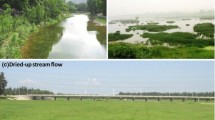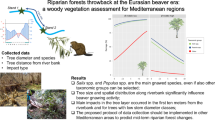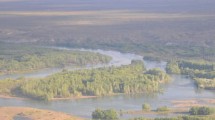Abstract
Riparian zones associated with alluvial rivers are spatially dynamic, forming distinct vegetative mosaics that exhibit sharp contrasts in structure and processes related to the underlying biophysical template. The productivity of riparian plants, especially trees, influences streamside community characteristics as well as the forms and fluxes of organic matter to adjacent streams – thereby strongly impacting patterns of channel morphology, water flow, sedimentation, and habitat in rivers. As part of a comprehensive investigation of riparian dynamics in coastal rain forest rivers of the Pacific Northwest (USA), we examined riparian tree abundance (density, basal area, and biomass) and rates of production (basal area growth [BAI] and bole wood biomass increase [P]) of seven common species – red alder (Alnus rubra), Sitka spruce (Picea sitchensis), bigleaf maple (Acer macrophyllum), western hemlock (Tsuga heterophylla), black cottonwood (Populus trichocarpa), vine maple (Acer circinatum) and willow (Salix spp.) – in the lowland floodplain of the Queets River (Olympic National Park), Washington. Measurements were made annually for three years (1999 – 2001) in 16 permanent plots on three biophysical templates that formed a toposequence – active floodplain, young terrace and mature terrace. Stem density was highest in the active floodplain (∼27,000 stems/ ha), decreasing in the young terrace (∼2,700 stems /ha) and the mature terrace (∼500 stems/ha). Basal area and total stem biomass were lowest in the active floodplain (∼16 m²/ha and ∼18 Mg dry weight/ha, respectively) and higher on the young terrace (∼32 m²/ha and ∼134 Mg dry weight/ha) and on the mature terrace (∼69 m²/ha and ∼540 Mg dry weight /ha). Total plot-scale BAI was not significantly different among the physical templates with mean values ranging from approximately 1.4 (low terrace) to approximately 2.8 m²/ha/y (active floodplain). In contrast, P was significantly higher on the mature terrace (10.3 Mg/ha) than the active floodplain (3.2 Mg/ha) but there was no significant difference between young terrace (6.5 Mg/ha) and mature terrace. For the entire Queets River floodplain (57 km2 over 77 km of river length), the mature terrace contributed 81% of the total annual production (28,764 Mg) whereas the active floodplain and young terrace accounted only for 5 and 14%, respectively. Overall, we show that riparian trees grow quickly in this coastal Pacific Northwest system and that the older riparian forests on mature terraces are the main contributors to stem production at the plot and floodplain scales for at least 350 years after stand initiation. This suggests that, in combination with the rapid lateral migrations of many alluvial rivers, the older riparian forests on those terraces are important and sustained sources of organic matter (especially large woody debris, LWD) that, over decades to centuries, shape the character of coastal rivers in the Pacific Northwest.







Similar content being viewed by others
References
Abbe TB, Montgomery DR. 1996. Large woody debris jams, channel hydraulics, and habitat formation in large rivers. Regul River 12:201–21
Abbe TB, Montgomery DR. 2003. Patterns and processes of wood debris accumulation in the Queets River basin, Washington. Geomorphology 51:81–107
Acker SA, Halpern CB, Harmon ME, Dyrness CT. 2002. Trends in bole biomass accumulation, net primary production, and tree mortality in Pseudotsuga menziesii forests of contrasting age. Tree Physiol 22:213–217
Acker SA, Gregory SV, Lienkaemper G, McKee WA, Swanson FJ, Miller SD. 2003. Composition, complexity, tree mortality in riparian forests in the central Western Cascades of Oregon. Forest Ecol Manag 173:293–308
Agee JK. 1988. Successional dynamics in forest riparian zones. In: Raedke KJ, Ed. Streamside management: Riparian wildlife and forestry interactions. University of Washington, Institute of Forest Resources, Seattle, Washington, USA, pp 31–43
Alaback PB, Juday GP. 1989. Structure and composition of low elevation old-growth forests in research natural areas of southeast Alaska. Nat Area J 9:27–39
Balian EV. 2001. Stem production dynamics of dominant riparian trees in the Queets River Valley, Washington. M. Sc. Thesis. University of Washington, Seattle, Washington, USA
Bechtold JS, Edwards RT, Naiman RJ. 2003. Biotic versus hydrologic control over seasonal nitrate leaching in a floodplain forest. Biogeochemistry 63:53–72
Bell JH, Lauer JL, Peek JM. 1992. Habitat use patterns of White-tailed deer, Umilla River, Oregon. Northwest Sci 3:160–171
Bilby RE, Bisson PA. 1998. Function and distribution of large woody debris. In: Naiman RJ, Bilby RE, Eds. River ecology and management. New York, USA: Springer-Verlag, pp. 324–46
Binkley D, Cromack K, Baker DD. 1994. Nitrogen fixation by red alder: biology, rates and controls. In: Hibbs DE, DeBell DS, Tarrant RF, Eds. The biology and management of red alder. Corvallis USA: Oregon State University Press, pp. 57–72
Bisson PA, Bilby RE, Bryant MD, Dolloff CA, Grette GB, House RA, Murphy ML, Koski KV, Sedell JR. 1987. Large woody debris in forested streams in the Pacific Northwest: past, present and future. In: Salo EO, Cundy TW, Eds. Streamside management: forestry and fisheries interactions. Seattle, Washington, USA: University of Washington, Institute of Forest Resources. p 143–90
Bonan GB, Shugart HH. 1989. Environmental factors and ecological processes in boreal forests. Annu Rev Ecol Syst 20:1–28
Bormann BT, Sidle RC. 1990. Changes in productivity and distribution of nutrients in a chronosequence at Glacier Bay National Park, Alaska. J Ecol 78:561–78
Bormann BT, Cromack K, Russell WO III. 1994. Influences of red alder on soils and long-term ecosystem productivity. In: Tarrant RF, Ed. The biology and management of red alder. Corvallis, Oregon, USA: Oregon State University Press, pp 47–56
Braatne JH, Rood SB, Heilman PE. 1996. Life history, ecology, conservation of riparian cottonwoods in North America. In: Stettler RF, Bradshaw HD, Jr., Heilman PE, Hinckley TM (Eds). Biology of populus and its implications for management and conservation. NRC Research Press, National Research Council of Canada, Ottawa, Ontario, Canada, pp 57–85
Brinson MM. 1990. Riverine forests. In: Lugo AE, Brinson MM, Brown S, Eds. Forested wetlands. Amsterdam, The Netherlands: Elsevier Scientific Publishers, pp 87–141
Brinson MM, Bradshaw HD, Kane ES. 1980. Nitrogen cycling and assimilative capacity of nitrogen and phosphorus by riverine wetlands forests. Report No 167, Water Resources Research Institute, University of North Carolina, Raleigh, North Carolina, USA
Campbell AG, Franklin JF. 1979. Riparian vegetation in Oregon’s Western Cascade Mountains: composition, biomass and autumn phenology. Coniferous Forest Biome Bulletin 14. Oregon State University, Corvallis, Oregon, USA
Case RL, Kauffman JB. 1997. Wild ungulate influences on the recovery of willows, black cottonwood, and thin leaf alder following cessation of cattle grazing in northeastern Oregon. Northwest Sci 71:115–26
Clinton SM. 2001. Microbial metabolism, enzyme activity, and production in the hyporheic zone of a floodplain river. Ph.D. Dissertation. University of Washington, Seattle, Washington, USA
Cook JE. 1996. Implications of modern successional theory for habitat typing: a review. Forest Sci 42:67–75
Edmonds RE, Thomas TB, Maybury KP. 1993. Tree population dynamics, growth, mortality in old-growth forests in the Western Olympic Mountains, Washington. Can J Forest Res 23:513–9
Fetherston KL, Naiman RJ, Bilby RE. 1995. Large woody debris, physical process, riparian forest succession in montane river networks of the Pacific Northwest. Geomorphology 13:133–44
Fonda RW. 1974. Forest succession in relation to river terrace succession in Olympic National Park. Ecology 55:927–42
Franklin JF, Spies TA, Van Pelt R, Carey AB, Thornburgh DA, Berg DR, Lindenmayer DB, Harmon ME, Keeton WS, Shaw DC, Bible K, Jiquan C. 2002. Disturbances and structural development of natural forest ecosystems with with silvicultural implications, using Douglas-fir forests as an example. Forest Ecol Manag 155:399–423
Franklin JF, Dyrness CT. 1973. Natural vegetation of Oregon and Washington. General Technical Report PNW-8, USDA Forest Service, Pacific Northwest Forest and Range Experimental Station, Portland, Oregon, USA
Franklin JF, Cromack K Jr, Denison W, McKee A, Maser C, Sedell J, Swanson F, Juday G. 1981. Ecological characteristics of old-growth Douglas-fir forests. General Technical Report PNW-118, USDA Forest Service, Corvallis, Oregon, USA
Fujimori T. 1977. Stem biomass and structure of a mature Sequsia Sempervirens stand on the Pacific Coast of northern California. J Japanese Forest Soc 59:435–441
Gregory SV, Swanson FJ, McKee WA, Cummins KW. 1991. An ecosystem perspective of riparian zones. BioScience 41:540–51
Gregory SV, Boyer KL, Gurnell AM, (Eds). 2003. The ecology and management of wood in world rivers. American Fisheries Society, Symposium 37, Bethesda, Maryland, USA
Grier CC. 1976. Biomass, productivity, nitrogen-phosphorus cycles in hemlock-spruce stands of the central Oregon coast. In: Atkinson WA, Zasoski RJ, Eds. Proceedings, Western Hemlock Management Conference. University of Washington, College of Forest Resources, Seattle, Washington, USA
Grier CC, Logan RS. 1977. Old-growth Pseudotsuga menziesii communities of western Oregon watershed: biomass distribution and production budgets. Ecol Monogr 47:373–400
Grier CC, Lee KM, Nadkarni NM, Klock GO. 1989. Productivity of forests of the United States and its relation to soil and site factors and to management practices. USDA, Forest Service, Pacific Northwest Research Station, Portland, Oregon, USA
Halpern CB. 1989. Early successional patterns of forest species: interactions of life history traits and disturbance. Ecology 70:704–20
Hanley TA, Hoel T. 1996. Species composition of old-growth and riparian Sitka spruce- western hemlock forests in southeastern Alaska. Can J Forest Res 26:1703–8
Harcombe PA, Harmon ME, Greene SE. 1990. Changes in biomass and production over 53 years in a coastal Picea sitchensis–Tsuga heterophylla forest approaching maturity. Can J Forest Res 20:1603–11
Harner MJ, Stanford JA. 2003. Differences in cottonwood growth between a losing and a gaining reach of an alluvial floodplain. Ecology 84:1453–8
Hawk GM, Zobel DB. 1974. Forest succession on alluvial landforms of the McKenzie River Valley, Oregon. Northwest Sci 48:245–65
Helm D, Collins W, McKendrick J. 1984. Floodplain vegetation succession in south-central Alaska. In: LaBao VJ, Kerr CL, Eds. Inventorying forest and other vegetation of the high latitude and high altitude regions. Proceedings of a symposium, July 23–26, 1984. Society of American Foresters, Fairbanks, Alaska, USA, p 114–8
Hughes FMR. 1997. Floodplain biogeomorphology. Prog Phys Geogr 21:501–29
Hush B, Miller CL, Beers TW. 1982. Forest mensurations, Third edition. Krieger Publishing Company, Malabar, Florida, USA
Kimmins JP. 1997. Forest Ecology: A foundation for sustainable management, Second edition. Prentice-Hall Inc., Upper Saddle River, New Jersey, USA
Kozlowski TT, Kramer PJ, Pallardy SG. 1991. The physiological ecology of woody plants, San Diego, California: Academic Press, p 657
Lee LC. 1983. The floodplain and wetland vegetation of two Pacific Northwest river ecosystems. Ph.D Dissertation. University of Washington, Seattle, Washington, USA
Luken JO, Fonda RW. 1983. Nitrogen accumulation in a chronosequence of red alder communities along the Hoh River, Olympic National Park, Washington. Can J Forest Res 13:1228–37
MacBride JR, Strahan J. 1984. Establishment and survival of woody riparian species on gravel bars of an intermittent stream. Am Midl Nat 112:235–45
MacMahon JA. 1980. Ecosystems over time succession and other types of change. In: Waring RH, Ed. Forests: fresh perspectives from ecosystem analysis. Corvallis, Oregon, USA: Oregon State University Press, pp 27–57
Markwardt LJ, Wilson TRC. 1935. Strength and related properties of woods grown in the United States. Technical Bulletin 479, USDA Forest Service, Forest Production Lab. Div. Res., Madison, Wisconsin, USA
Maser C, Sedell JR. 1994. From the forest to the sea: the ecology of wood in streams, rivers, estuaries, oceans. St. Lucie Press, Delray Beach, Florida, USA
McKee A, Laroi G, Franklin JF. 1982. Structure, composition, reproductive behavior of terrace forests, South Fork Hoh River, Olympic National Park. In: Starkey EE, Franklin JF, Matthews JW, Eds. Ecological research in National Parks of the Pacific Northwest. National Park Cooperative Unit, Corvallis, Oregon, USA, pp 22–9
Means JE, Harris RR, Sabin TE, McCain CN. 1996. Spatial variation in productivity of Douglas-fir stands on a valley floor in the Western Cascades Range, Oregon. Northwest Sci 70:201–11
Means, JE, Hansen HA, Koerper GJ, Alaback PB, Klopsch MW. 1994. Software for computing plant biomass–BIOPAK users guide. Gen. Tech. Rep. PNW-GTR-340. Portland, OR: U.S. Department of Agriculture, Forest Service, Pacific Northwest Research Station
Minore D, Smith CE. 1971. Occurrence and growth of four northwestern tree species over shallow water tables. Research Note USDA Forest Service, Portland, Oregon, USA
Montgomery DR. 1999. Process domains and the river continuum. J Am Water Resour As 35:397–410
Naiman RJ, Bechtold JS, Drake D, Latterell JJ, O’Keefe TC, Balian EV. 2005a. Origins, patterns, importance of heterogeneity in riparian systems. In: Lovett G, Jones CG, Turner MG, Weathers KC, Eds. Ecosystem function in heterogeneous landscapes. New York: Springer-Verlag p 279–309
Naiman RJ, Bilby RE, Bisson PA. 2000. Riparian ecology and management in the Pacific coastal rain forest. BioScience 50:996–1011
Naiman RJ, Décamps H, McClain ME. 2005b. Riparia: Ecology, conservation, and management of streamside communities. San Diego: Academic Press, Elsevier
Neter J, Kutner MH, Nachtsheim CJ, Wasserman W. 1996. Applied linear regression models. Third edition, 1996, Irwin, Chicago, USA. p 1050
Niernberg TR, Hibbs DE. 2000. A Characterization of unmanaged riparian areas in the central coast range of Western Oregon. Forest Ecol Manag 129: 195–206
O’Connor JE, Jones MA, Haluska TL. 2003. Flood plain and channel dynamics of the Quinault and Queets rivers, Washington, USA. Geomorphology 51:31–59
Pabst RJ, Spies TA. 1999. Structure and composition of unmanaged riparian forests in the coastal mountains of Oregon, USA. Can J Forest Res 29:1557–73
Peet RK. 1981. Changes in biomass and production during secondary forest succession. In: West DC, Shugart HH, Botkin DB, Eds. Forest succession: concepts and applications. New York, USA: Springer-Verlag, pp 324–38
Phipps RL. 1985. Collecting, preparing, crossdating, measuring tree increment cores. Water Resources Investigations Report 85–4148. United States Geological Survey, Reston, VA
Poage NJ, Spies TA. 1996. A tale of two unmanaged riparian forests. Report 9, Coastal Oregon Productivity Experiment (COPE), Corvallis, Oregon, USA
Robinson EG, Beschta RL. 1990. Identifying trees in riparian areas that can provide coarse woody debris to streams. Forest Sci 36:790–801
Roe AL. 1958. Silvics of black cottonwood. Miscellaneous Publication 17 USDA Forest Service, Intermountain Forest and Range Experiment Station, Berkeley, California, USA
Ruth RH. 1965. Sitka spruce (Picea sitchensis (Bong.) Carr.). In: Fowells HA, Ed. Silvics of Forest Trees of the United States. USDA Forest Service, Washington DC, USA, pp 311–7
Ryan MG, Binkley D, Fownes JH. 1997. Age-related decline in forest productivity: pattern and process. Adv Ecol Res 27:213–62
Sedell JR, Bisson PA, Swanson FJ, Gregory SV. 1988. What we know about large trees that fall into streams and rivers. In: Maser C, Tarrant RF, Trappe JM, Franklin JF, Eds. Form the forest to the sea: a story of fallen trees. USDA Forest Service General Technical Report PNW-GTR-229, p 47–81
Sedell JR, Yuska JE, Speaker RW. 1982. Habitats and salmonid distribution in pristine, sediment-rich river valley systems: S. Fork Hoh and Queets River, Olympic National Park. In: Meehan WR, Merrell TR, Hanley TA, Eds. Fish and wildlife relationships in old-growth forests. Proceedings of a Symposium held in Juneau, Alaska, 12–15 April 1982. American Institute of Fisheries Research Biologists, p 33–44
Seymour RS, Kenefic LS. 2002. Influence of age on growth efficiency of Tsuga canadensis and Picea rubens trees in mixed-species, multiaged northern conifer stands. Can J Forest Res 32:2032–42
Smith W. 1970. Wood density survey in western Canada. Information Report VP-X-66, Canadian Department of Fishery and Forestry, Canadian Forest Service, Ottawa, Ontario, Canada
Stokes MA, Smiley TL. 1968. An introduction to tree ring dating. The University of Chicago Press. Chicago and London, p 73
Tappeiner JC, Huffman D, Spies TA, Bailey JD. 1997. Density, ages and growth rates in old-growth and young growth forests in coastal Oregon. Can J Forest Res 27:638–48
Tockner K, Ward JV, and others. 2003. The Tagilamento River: A model ecosystem of European importance. Aquat Sci 65:239–53
Urban DL, Miller C, Halpin PNS. 2000. Forest gradient response in Sierran landscapes: the physical template. Landscape Ecol 15:603–20
Van Miegroet H, Cole CV. 1984. The impact of nitrification on soil acidification and cation leaching in a red alder ecosystem. Journal of Environ Qual 13:586–90
Van Pelt R. 1991. Colonization of Alluvium along two Rivers in Western Washington. Ph.D. Thesis. University of Washington, Seattle, Washington, USA
Van Pelt R, O’Keefe TC, Latterell JJ, Naiman RJ. 2005. Structural development and stand evolution of riparian forests along the Queets River, Washington. Ecol Monogr (in press).
Viereck LA, Dyrness CT, Foote MJ. 1993. An overview of the vegetation and soils of the floodplain ecosystems of the Tanana River, interior Alaska. Can J Forest Res 23:889–98
Walker LR. 1993. Nitrogen fixers and species replacements in primary succession. In: Miles J, Walton DWH, Eds. Primary succession on land. Special Publication Number 12 of the British Ecological Society. Oxford, England: Blackwell Scientific Publications, pp 249–72
Walker LR, Zasada JC, Chapin FS III. 1986. The role of life history processes in primary succession on an Alaskan floodplain. Ecology 67:1243–53
Webster JR, Meyer JL. 1997. Stream organic matter budgets: Introduction. J N Am Benthol Soc 16:3–14
Zavitkovski J, Stevens RD. 1972. Primary productivity of red alder ecosystems. Ecology 53:235–42
Acknowledgements
Research support was provided by the Andrew W. Mellon Foundation, the Pacific Northwest Research Station of the US Forest Service, Anchor Environmental L.L.C., and the American Water Resources Association. We thank the Olympic National Park for permission (Park study number OLYM-0047), and especially personnel from the Kalaloch Ranger Station for logistic support. We are grateful to J.S. Bechtold, D.C. Drake, R.T. Edwards, T. Hinckley, J.J. Latterell, T.C. O’Keefe, D.L. Peterson, and R. Van Pelt for constructive discussions, reviews, and use of data. K. Overberg and B. Congleton helped with fieldwork and Josh Latterell and Erin Meehan created digital floodplain coverages from aerial photographs and maps.
Author information
Authors and Affiliations
Corresponding author
Rights and permissions
About this article
Cite this article
Balian, E.V., Naiman, R.J. Abundance and Production of Riparian Trees in the Lowland Floodplain of the Queets River, Washington. Ecosystems 8, 841–861 (2005). https://doi.org/10.1007/s10021-005-0043-4
Received:
Accepted:
Published:
Issue Date:
DOI: https://doi.org/10.1007/s10021-005-0043-4




